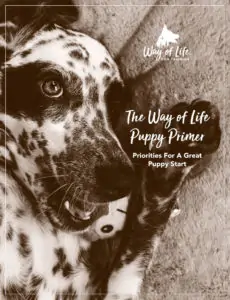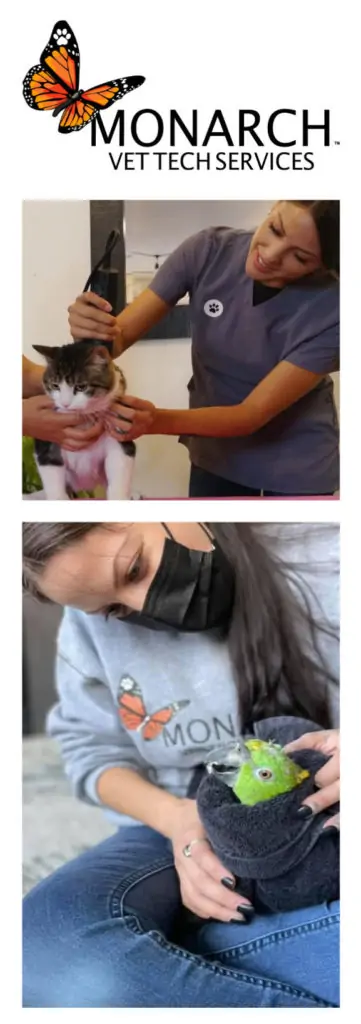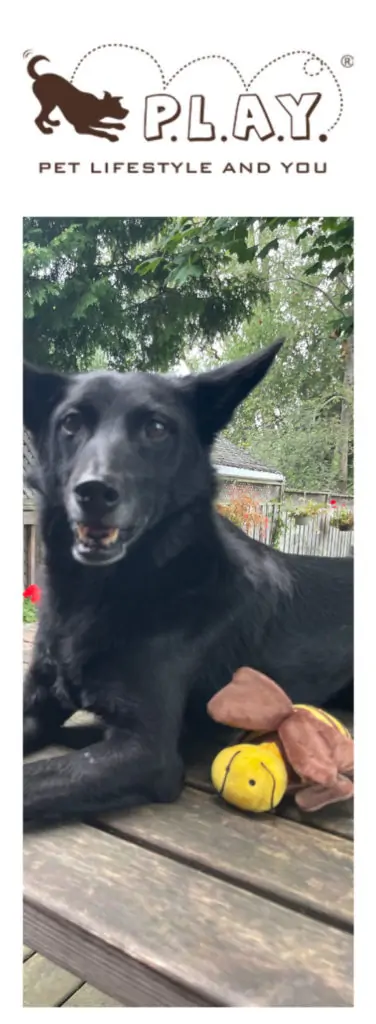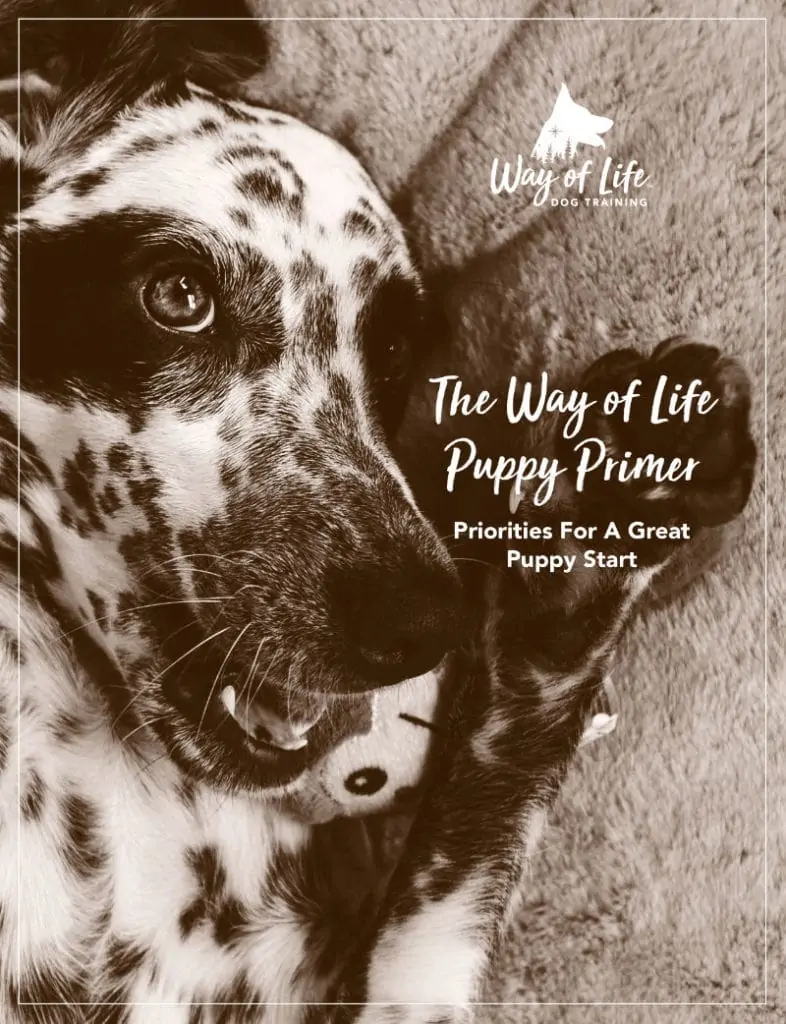If you’re a dog lover, you’ve probably experienced the pure joy of holding a puppy in your arms. Who here hasn’t fallen for the intoxicating smell and sweet innocence of puppies? Regardless of breed, shape, or size, puppies are simply a delight.
At the same time, it’s that very innocence that can get us in such trouble. On the one hand, it’s hard not to want to nurture and protect something this vulnerable. On the other, we’ll often allow ourselves to fall in love a little too soon. We’ll let our strong feelings cloud the objectivity required to raise a solid dog.
Many people have contacted me to say they’re unsure of what to do in those early days and weeks. Many more have come with young dogs exhibiting issues that could have been avoided had things been done correctly from puppyhood. That’s why I decided to create and share a free guide for getting off to a good start with your new pup. Click on the box below for the Way of Life™ Dog Training Puppy Primer, which I hope you’ll enjoy, find useful, and share with others.
In addition to the primer, this issue of the newsletter includes a reflection on the importance of taking responsibility for our dogs, some pro tips for loose leash walking, and a discussion of whether WOLDT uses “force” or “force free” methods.
I want to also remind you that we’re now on Facebook! While I resisted going on social media for the longest time, I’ve come around to acknowledging its potential to inspire a different way of living with and relating to dogs. I’ll be sharing my interpretations of canine behavioural issues and passing along tidbits and recommendations. I’m also open to your suggestions, so please let me know how the page can serve you and your relationship with your dog.
Please Follow and mark the page as a Favourite, and share with your family and friends if you haven’t already. It’s been wonderful connecting with you online and I look forward to growing our community.
Wishing you and your loved ones an amazing Fall and see you again soon!
Warmly,
~ Souha
The Way Of Life Puppy Primer
(Click Here to Download the PDF)

Reflecting On Our Bond
Taking Responsibility for Our Dogs
We all know that we need to take responsibility for our dogs – for their care, feeding and vetting, training, socialization, and general wellbeing. And yet, there are some in the dog training community who believe that we aren’t responsible for our dogs’ behaviour and that their behaviour doesn’t reflect us.
Recently, I came across a social media post that said just that. The writer’s view was that our dog’s behaviour is not a reflection of us, but rather of its genetics, environmental conditions, unique temperament, learning history, and “what has/hasn’t happened that day.”
In addition, the post stated that living with dogs, while an incredible gift is also really hard. That making ourselves responsible doesn’t help but only adds to the difficulty. Ultimately, the post concluded we can all “exhale” knowing that even science says this to be true.
Living with dogs is a gift and I agree that it isn’t always fun or easy. I also know from personal experience just how much guilt we can carry when our dogs have problems. I understand the good intentions behind wanting to let people off the hook and not saddling our training clients with such shame that they give up and then we can’t help them.
But if you’ve been with me a while, you’ll know that I passionately disagree with the notion that we aren’t to a great extent responsible for our dogs’ behaviour. I’d be curious to see the kind of science that would back such a claim. I’d love to see any studies demonstrating that the person who feeds, trains, walks, and socializes the dog doesn’t matter. That how that person might relate to and interact with the dog, how they might feel and think about the dog are irrelevant. That traits a person has, such as being anxious or stable, lazy or driven, would have no bearing on the dog. To claim that science justifies we not take responsibility for our dogs diminishes both science and people’s capacity to do better and be better. Can you tell that this attitude makes me more than a little hot under the collar?
It’s important to note that taking responsibility doesn’t imply that we’re the only force at play. Nor are we to blame for everything. Rather, it’s about owning our part and recognizing our influence. I mean, aren’t we in part accountable for the dog’s learning history and “what has/hasn’t happened that day”?
And of course genetics play an immense role in shaping temperament and behaviour. But genetics are the “nature” part while we, as the guardians of our dogs, bring forth the “nurture” part, i.e., the environmental conditions that actualize a dog’s genetic potential and can even transcend it.
It’s also true that too many dogs come with pain and trauma from past abuse, neglect, or simple misunderstanding and mismanagement. Many owners of such rescue dogs will use the past to justify why the dog is still problematic. As veteran trainer and author Suzanne Clothier put it: “Sometimes the dog’s history becomes baggage that the human carts along for the dog’s entire life.”
It’s up to us to model for the dog the hope and optimism of a better tomorrow and cultivate the kinds of bonds that heal wounds. I know without a doubt that dogs do better with those who celebrate their capacity to recover than with those who dwell on the hurt of the past.
When I was first told to look at myself for why my dog was troubled, it was hard to hear at first. Later, I breathed a sigh of relief because I knew I could do something and thus ultimately experienced this truth as liberating and empowering.
Taking responsibility means we seize every opportunity to do right by our dogs, even if it involves the challenging work of changing how we think and feel. Even if it means changing who we are.
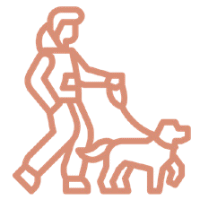
Pro Tip
Loose Leash Walking
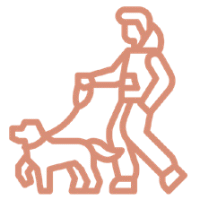
We all want to be able to walk our dogs on a loose leash and yet many of us struggle to do so. Our dogs pull us, chase after moving objects, and might even exhibit ”leash aggression.” This common predicament has spurred a lucrative market of countless devices meant to prevent dogs from pulling – head halters, prong collars, choke chains, no-pull harnesses, electronic collars, etc. All cause a dog discomfort and pain, while giving owners the false impression that they’ve solved their problem.
A dog’s leash manners are not just a matter of training. Rather, they reflect a dog that is relatively calm and enjoys a measure of a bond with its human. When we have a bond, we have a dog looking up at its person, minding its person, and wanting to remain close enough to its person. In other words, leash pulling is a symptom of a poor relationship and a lack of engagement between handler and dog. That’s why it’s ineffective and unfair to slap a control tool on a dog and call it a day.
Our relationship is a product of our way of life. I’ll often tell clients that their issues with leash pulling outside the house often reflect how things are being done inside the house. As pulling reflects a lack of engagement between person and dog, juicing up that engagement requires thoughtfully managing the dog’s daily life. This means having the dog on a schedule that involves alternating between crating or containing the dog and training/exercise sessions. This creates a climate that’s conducive to training our dog effectively.
Before hitting the busy sidewalks, begin your leash work in a space that’s quiet – the backyard if you have one or as quiet and private an area as you can access. Instead of the conventional 4-6-foot walking leash, work with a long 10-15-foot training line. Begin walking and engage your dog to follow, rewarding it with praise, smiles, food, and/or pats – whatever works in the early going. If the dog gets a little distracted, walk in a different direction. Depending on the kind of dog I’m dealing with, I might call and encourage the dog or let slight tension on the line prompt the dog to follow. With pups, I let them drag the line and follow me around for toys, food, or in response to movement and sounds. All too often, we strap puppies into a harness, knowing that they will pull but we don’t want them hurting their necks, and off onto the busy streets we go. At this point, keep it simple. It’s just you and your dog to start, but as you two get the hang of it, you’ll start allowing for distractions and expanding to gradually busier places.
Working on a long line in this manner, referred to as “lunge line work” by both dog and horse trainers, eases tension on the line and gives the animal a degree of choice. It helps us forget that there’s a line connecting us and makes walking together a habit that’s developed gently over time. As we make progress, we shorten the line and take our practice to different places, eventually making our way to narrow and busy sidewalks. Being able to move safely and in harmony is a necessity but also I think many would agree that walking together is one of the great pleasures of life with our dogs. When we walk with that leash loose and it’s nice and easy, this goes beyond training and speaks to our way of life.
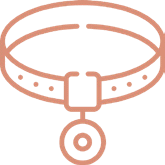
“Don’t ever think I fell for you, or fell over you. I didn’t fall in love, I rose in it.”
~ Toni Morrison
(American novelist, essayist, editor, and university professor)
Ask Way of Life™ Dog Training
Q: We have heard that trainers differ in terms of whether they use “positive reinforcement” or whether they use force and physical punishment. Which method of training do you use?
A: I’m happy to explain the Way of LifeTM position on the often-contentious issue in dog training of «force» versus «force-free» approaches.
First of all, let it be clear that Way of LifeTM Dog Training does not condone the use of methods that involve overpowering dogs, punishing, and “dominating” them in the old school ways. We do not use or endorse any tool that would give humans an unfair advantage on the dog. This includes devices such as prong collars, choke chains, and electronic collars as well as tools regularly used by the “force-free” crowd, such as head halters and no-pull harnesses.
Which leads me to my next point about whether “force free” methods are indeed so. Over and over again, I’ve seen “pure positive” trainers strap a head halter on a dog, a tool I firmly believe dogs find offensive and painful. Of course, the owner will have been instructed on how to use “science-based” methods to condition the dog to tolerate the intolerable. That same faction is also quite vocal about keeping dogs leashed up but letting them run around like idiots in places such as dog parks and doggie daycares. I find none of these beliefs and practices to be either positive or force free.
It’s a real shame that the world of dog training has become defined by whether trainers use positive reinforcement, whether they endorse force and physical punishment, or whether they’re considered “balanced.” These options might appear quite different and yet they all share a superficial behaviourist understanding of dogs. Behaviour “modification” through various forms of conditioning, shaping, or desensitization is their thing. They equate training with conditioning surface behaviour using carrots, sticks, or both, at the expense of understanding inner dynamics or addressing root causes.
Yet, if I attempt to modify a behaviour without really working at the causal level, all I’ve done is suppress a dysfunction that will sooner or later manifest elsewhere. My job as a trainer is to go deeper than surface behaviour, to look at the way of life for answers, and examine the resulting relationship for clues. Context is powerful; yet it’s given lip service in a world of dog training that’s obsessed with the symptom.
My role as coach is to help my clients understand their dogs’ issues as symptoms of a problem as opposed to being the problem. They come to see how their own attitude and behaviour are affecting their dogs. They come to appreciate how their dog is a product of its way of life. Therefore, we work on changing the context and setting the dog up for success, which means that at the start, when our bond is fragile, success is the only option. This is true of both puppies or an adult rescue. Having been consistently successful, our bond strengthens and so do our dogs. When mistakes happen, which they will as the dog matures and we start to do more, our level of credibility with the animal is such that gentle reminders are all that’s required and the dog gladly heeds.
In sum, my approach puts the emphasis on the handlers and the life context they create for their dogs. I always tell my clients that the dogs will be sane when they are handled sanely. This includes what we do each day and who we are to our dogs in each moment. Clients who have started with me from the get-go have come to see how little of the traditional mode of training is actually needed and that they can do without painful tools when the context is right and the connection is real.

Thank you for your excellent questions – please keep them coming!
Seasonal Suggestions

Biothane Collars and Leads
One of the first things I do with a new client is ensure that they have the right gear to work with their dogs, particularly the right lead and flat or martingale collar. As explained in the Pro Tip, I use long 10-15 foot leads with a beginner dog:
- A 1/4- or 3/8-inch thick lead for pups and small dogs
- A 1/2 thick lead for medium/regular-sized dogs
- A 3/4 inch thick lead with little nubbies for extra grip for strong/larger dogs
Eventually, I pare down to a six-foot line with a mature and steady dog. The material of these leads and collars is biothane, a rapidly growing alternative to leather. Dog trainers and handlers are finding biothane products to be affordable, durable, easy to clean, and suitable for all kinds of weather and activities. Personally, I like the heavy weight and “presence” of the material more than nylon, fabric, or even leather, as it makes the dog more aware of us while also making it easier to manage a lead of this length. Here are a few manufacturers of biothane collars and leads:
Monarch Vet Tech Services
Monarch Vet Tech Services, a team of vet techs and vet tech assistants, offer a variety of medical and grooming services right in the comfort of your home. They operate in Toronto and Scarborough but are often able to assist folks outside their service area. Owner and founder Veronica Oggy takes pride in serving seniors or people with disabilities who are unable to take their pets in for vet care. The company is able to deal with all kinds of animals including dogs, cats, birds, rabbits, and reptiles. Their menu of services includes:
- Medical Assistance: Administering eye, oral, or ear medication, injections, anal gland expression, and blood or urine collection.
- Grooming Services: Nail trims, ear cleaning, toothbrushing, and full cut and groom services for cats and small- to medium-sized dogs.
- Pet Sitting Services: House calls, medical visits, transportation, and delivery of food or medication.
As the Monarch vet tech team are not veterinarians, they cannot diagnose conditions, prescribe medications, or perform medical or surgical procedures. Medical treatments must be prescribed by the family vet.
To book your appointment, call (647) 668-4762
or e-mail v@monarchvts.com
Pet Lifestyle & You (P.L.A.Y.) Dog Toys
A manufacturer of quality eco-friendly pet products based in San Francisco, California, P.L.A.Y. takes pride in creating a positive impact on “pets, people and planet.” The company is a Certified B Corporation producing quality sustainable products for dogs and cats, including ergonomic crate mats and pet beds, travel accessories, collars and leashes, and indoor and outdoor toys. Their toys are certified non-toxic and have been tested to meet child safety standards. Their plush toys are machine washable, with double-layered fabrics and inverted stitching for added durability, and are stuffed with P.L.A.Y.’s safe and sustainable PlanetFill® polyfiber. Worth noting about their plush toys is how they’re organized into such cute and creative collections. For the big dogs, check out the Safari collection comprising Ernie the Elephant and Zara the Zebra. For the little dogs, the Bugging Out collection is “inspired by our earth’s friendly bugs” and includes Bella the Butterfly and Burt the Bee, pictured here with Bob. A percentage of the sales of both these collections benefit IFAW – The International Fund for Animal Welfare.
To locate retailers in Canada, go to:
https://www.petplay.com/apps/store-locator
Paws For the Camera
Introducing client Nimbus the German Shepherd. His dad and I met a few years back but didn’t seriously work together until recently. Nimbus had become quite anxious, aggressive to dogs, and showed signs of increasing hostility towards people. Turns out, my client had moved in with his new love and the couple was not quite in sync when it came to the dog. These differences of opinion resulted in tension and conflicts around the dog and inconsistencies in his handling. A German Shepherd’s natural need for leadership and order did not take well to the situation and his behaviour rapidly deteriorated. Luckily, the couple’s commitment to each other and to their dog has led to a remarkable change. To see Nimbus start to ease up has been great but it’s the transformation in the humans that’s been a real thrill to witness. While remaining consistent in their attitude and handling, they’ve each developed their own style and unique rapport with Nimbus, giving him the gift of not one but two people to look up to.
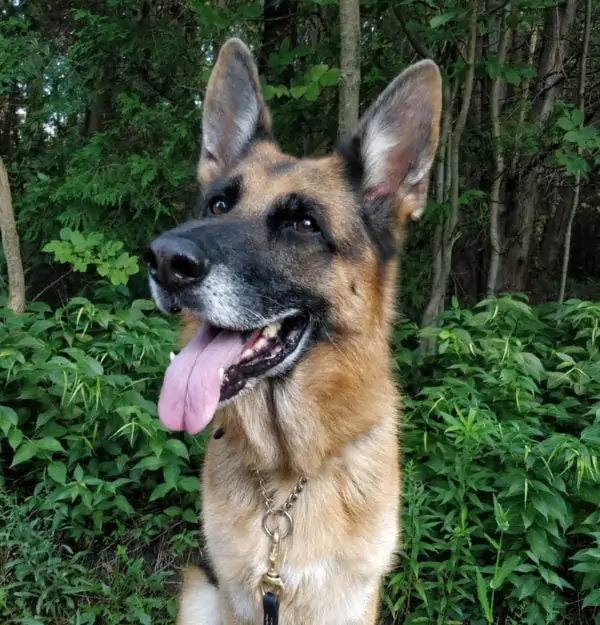
Pickering, ON
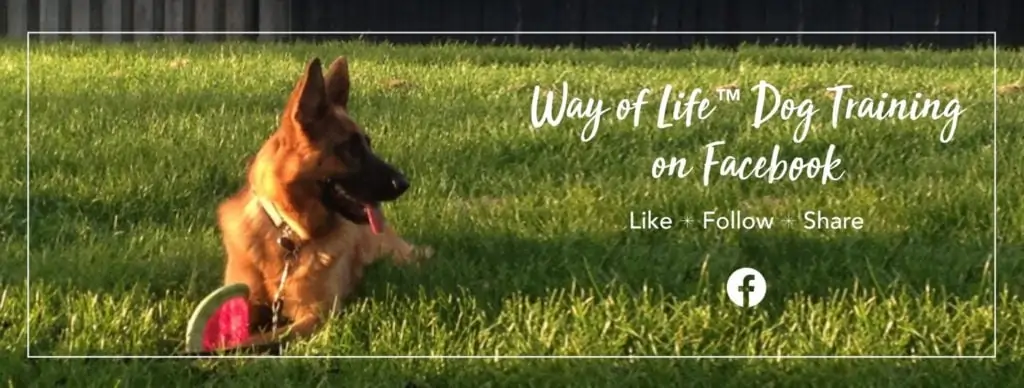

Is there a topic that you’d like me to cover in an upcoming newsletter or video? Please don’t hesitate to email suggestions or questions to info@wayoflifedogtraining.com.
Do you want to know more about transforming your relationship with your dog? Way of Life™ Dog Training is here to help.


